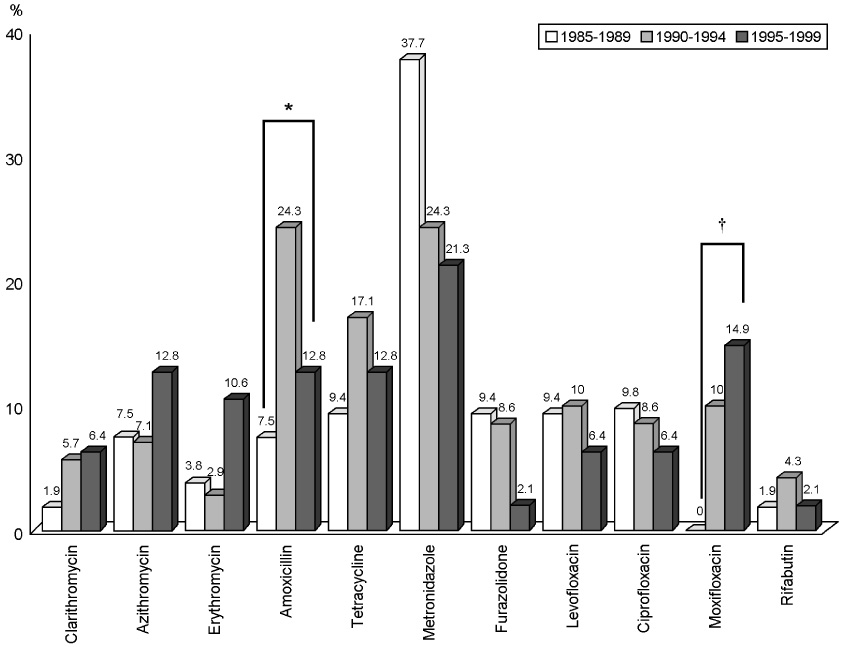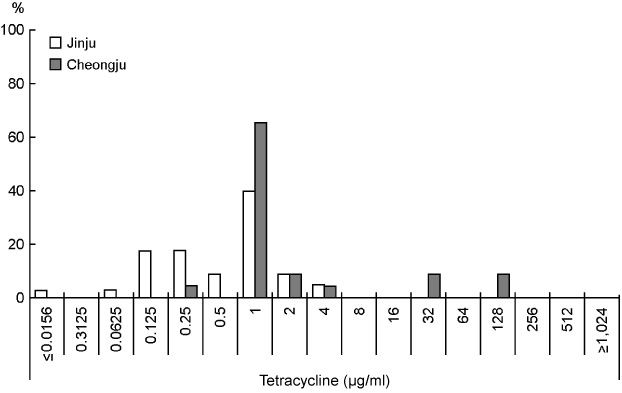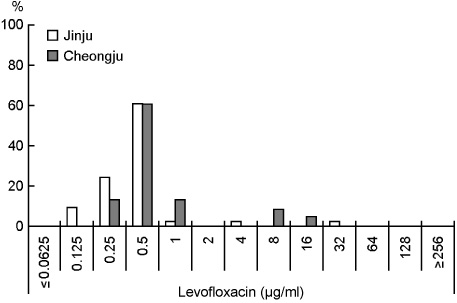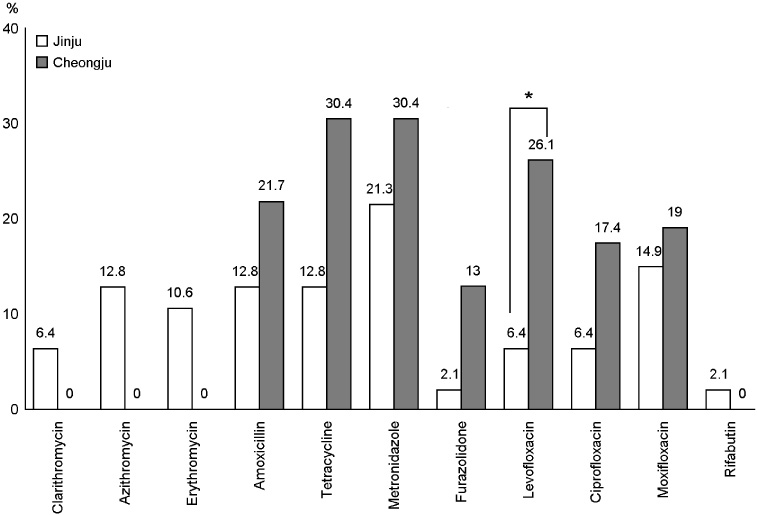J Bacteriol Virol.
2012 Dec;42(4):305-312. 10.4167/jbv.2012.42.4.305.
Comparison of the Antibiotic Resistance of Helicobacter pylori Isolated in Jinju Over a 15-year Period
- Affiliations
-
- 1Department of Pediatrics, Gyeongsang Institute of Health Sciences, School of Medicine, Gyeongsang National University, Jinju, Korea. hsyoun@gnu.ac.kr
- 2Department of Microbiology, Gyeongsang Institute of Health Sciences, School of Medicine, Gyeongsang National University, Jinju, Korea.
- KMID: 2168665
- DOI: http://doi.org/10.4167/jbv.2012.42.4.305
Abstract
- The aims of this study were to investigate the changing pattern of Helicobacter pylori antibiotic resistance in Jinju over a 15-year period. H. pylori strains were isolated from 170 adults living in Jinju from 1985-1989, 1990-1994 and 1995-1999, and from 23 adults living in Cheongju from 1995 to 1999. Susceptibility to erythromycin, clarithromycin, azithromycin, amoxicillin, tetracycline, metronidazole, furazolidone, levofloxacin, ciprofloxacin, moxifloxacin, and rifabutin was tested using the serial two-fold agar dilution method. Moxifloxacin resistance significantly increased in Jinju from 1985-1989 (0%) to 1995-1999 (14.9%) (p < 0.0001). Resistance to amoxicillin was increasesed trend to decreased trend from 1985 to 1999 (p = 0.033), whereas metronidazole resistance decreased from 37.5% to 21.3%. Resistance to furazolidone was greater from 1985-1989 (9.4%) than in 1995-1999 (2.1%). In comparing Jinju and Cheongju, minimal inhibitory concentrations (MICs) of tetracycline and levofloxacin among H. pylori isolated from Jinju were lower than for isolates from Cheonju (p < 0.05). The levofloxacin resistance rate was higher in Cheongju than in Jinju (p = 0.02). No macrolide resistance was observed in Cheongju. Overall, we did not observe any remarkable antimicrobial resistance increase of H. pylori strains isolated from Jinju over 15 years. The MIC distributions of antimicrobials and antimicrobial resistant rates were time- and region-specific among different strains. Future anti-H. pylori eradication regimens should be designed based on the changing patterns of antimicrobial resistance according to the resident area.
Keyword
MeSH Terms
-
Adult
Agar
Amoxicillin
Anti-Infective Agents
Aza Compounds
Azithromycin
Ciprofloxacin
Clarithromycin
Drug Resistance, Microbial
Erythromycin
Furazolidone
Helicobacter
Helicobacter pylori
Humans
Metronidazole
Ofloxacin
Quinolines
Rifabutin
Tetracycline
Agar
Amoxicillin
Anti-Infective Agents
Aza Compounds
Azithromycin
Ciprofloxacin
Clarithromycin
Erythromycin
Furazolidone
Metronidazole
Ofloxacin
Quinolines
Rifabutin
Tetracycline
Figure
Cited by 1 articles
-
Changes in the Treatment Strategies for Helicobacter pylori Infection in Children and Adolescents in Korea
Jin-Su Jun, Ji-Hyun Seo, Ji-Sook Park, Kwang-Ho Rhee, Hee-Shang Youn
Pediatr Gastroenterol Hepatol Nutr. 2019;22(5):417-430. doi: 10.5223/pghn.2019.22.5.417.
Reference
-
1. Bazzoli F, Pozzato P, Rokkas T. Helicobacter pylori: the challenge in therapy. Helicobacter. 2002. Suppl 1. 43–49.2. Bytzer P, O'Morain C. Treatment of Helicobacter pylori. Helicobacter. 2005. Suppl 1. 40–46.3. Kim N, Kim JJ, Choe YH, Kim HS, Kim JI, Chung IS. Diagnosis and treatment guidelines for Helicobacter pylori infection in Korea. Korean J Gastroenterol. 2009. 54:269–278.
Article4. Wolle K, Malfertheiner P. Treatment of Helicobacter pylori. Best Pract Res Clin Gastroenterol. 2007. 21:315.5. Glupczynski Y, Mégraud F, Lopez-Brea M, Anderson LP. European multicentre survey of in vitro antimicrobial resistance in Helicobacter pylori. Eur J Clin Microbiol Infect Dis. 2001. 20:820–823.
Article6. Eun CS, Han DS, Park JY, Jeon YC, Hahm JS, Kim KS, et al. Changing pattern of antimicrobial resistance of Helicobacter pylori in Korean patients with peptic ulcer diseases. J Gastroenterol. 2003. 38:436–441.
Article7. Mégraud F. Antibiotic resistance in Helicobacter pylori infection. Br Med Bull. 1998. 54:207–216.8. Thyagarajan SP, Ray P, Das BK, Ayyagari A, Khan AA, Dharmalingam S, et al. Geographical difference in antimicrobial resistance pattern of Helicobacter pylori clinical isolates from Indian patients: Multicentric study. J Gastroenterol Hepatol. 2003. 18:1373–1378.
Article9. Mégraud F. H. pylori antibiotic resistance: prevalence, importance, and advances in testing. Gut. 2004. 53:1374.
Article10. Meyer JM, Silliman NP, Wang W, Siepman NY, Sugg JE, Morris D, et al. Risk factors for Helicobacter pylori resistance in the United States: the surveillance of H. pylori antimicrobial resistance partnership (SHARP) study, 1993-1999. Ann Intern Med. 2002. 136:13–24.
Article11. Kalach N, Benhamou PH, Dupont C, Raymond J. Choosing triple therapy for Helicobacter pylori in children: antimicrobial resistance testing of first gastric biopsy culture may predict outcome. J Pediatr Gastroenterol Nutr. 2001. 32:225–226.
Article12. Marie MA. Patterns of Helicobacter pylori resistance to metronidazole, clarithormycin and amoxicillin in Saudi Arabia. J Bacteriol Virol. 2008. 38:173–178.
Article13. National Committee for Clinical Laboratory Standards. Acceptable limits for quality control strains used to monitor accuracy of minimal inhibitory concentrations (MICs) (µg/ml) of fastidious organisms. Performance standards for antimicrobial susceptibility testing. 2002. Vol. 22(no. 1 NCCLS):12th informational supplement. Wayne, PA, USA: M100-S12.14. Kim JM, Kim JS, Jung HC, Kim N, Kim YJ, Song IS. Distribution of antibiotic MICs for Helicobacter pylori strains over a 16-year period in patients from Seoul, South Korea. Antimicrob Agents Chemother. 2004. 48:4843–4847.
Article15. Kim N, Kim JM, Kim CH, Park YS, Lee DH, Kim JS, et al. Institutional difference of antibiotic resistance of Helicobacter pylori strains in Korea. J Clin Gastroenterol. 2006. 40:683–687.
Article16. Malfertheiner P, Mégraud F, O'Morain C, Hungin AP, Jones R, Axon A, et al. Current concepts in the management of Helicobacter pylori infection--the Maastricht 2-2000 Consensus Report. Aliment Pharmacol Ther. 2002. 16:167–180.
Article17. Lam SK, Talley NJ. Report of the 1997 Asia Pacific Consensus Conference on the management of Helicobacter pylori infection. J Gastroenterol Hepatol. 1998. 13:1–12.
Article18. Hunt RH, Fallone CA, Thomson AB. Canadian Helicobacter pylori Consensus Conference Update: infection in adults. Canadian Helicobacter Study Group. Can J Gastroenterol. 1999. 13:213–217.
Article19. Kim JH, Kim HY, Kim NY, Kim SW, Kim JG, Kim JJ, et al. Seroepidemiological study of Helicobacter pylori infection in asymptomatic people in South Korea. J Gastroenterol Hepatol. 2001. 16:969–975.
Article20. Jeon SK, Chang MW, Kim KH, Park ID. Analysis of clarithromycin resistance of Helicobacter pylori isolated in Korea. J Bacteriol Virol. 2003. 33:11–18.21. Bang SY, Han DS, Eun CS, Kim JE, Ahn SB, Sohn JH, et al. Changing patterns of antibiotic resistance of Helicobacter pylori in patients with peptic ulcer disease. Korean J Gastroenterol. 2007. 50:356–362.22. Jeong MH, Chung JW, Lee SJ, Ha M, Jeong SH, Na S, et al. Comparison of rifabutin- and levofloxacin-based third line rescue therapies for Helicobacter pylori. Korean J Gastroenterol. 2012. 59:401–406.
Article
- Full Text Links
- Actions
-
Cited
- CITED
-
- Close
- Share
- Similar articles
-
- Antibiotic Resistance of Helicobacter pylori: Mechanisms and Clinical Implications
- Antibiotic Resistance in Helicobacter pylori
- Antibiotics resistance of Helicobacter pylori and treatment modalities in children with H. pylori infection
- Eradication Therapy for Helicobacter pylori with Diagnostic Test for Clarithromycin Resistance
- Antibiotic Resistance of Helicobacter pylori Isolated from Korean Patients





